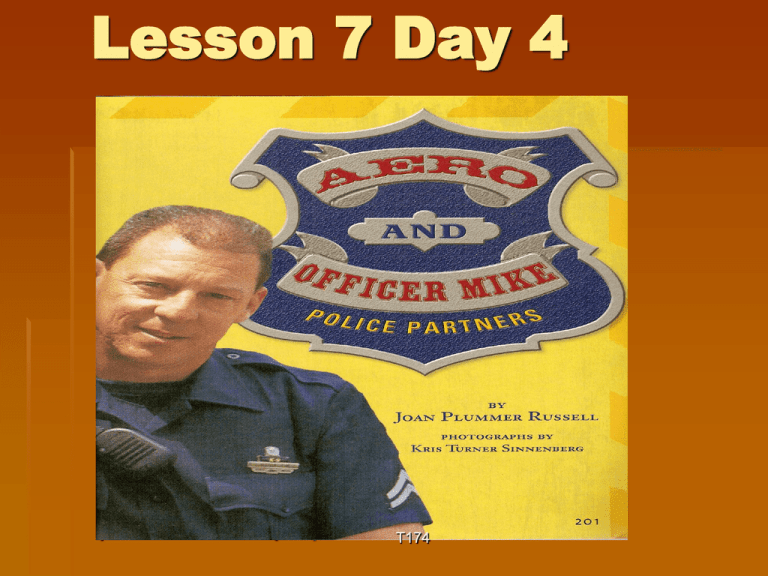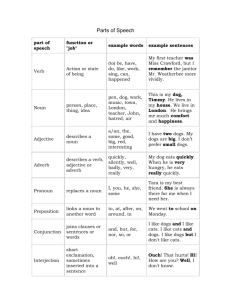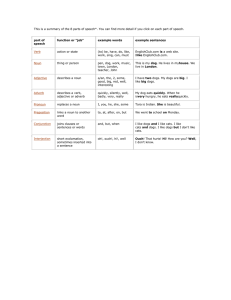Lesson 7 Day 4 You will need your reading book, T174
advertisement

Lesson 7 Day 4 You will need your reading book, pencil, and paper. T174 Question of the Day Why do dogs make good friends for many people? Dogs are our good friends because ____________. T174 Read Aloud You are going to read a selection about dogs. Why might you read or listen to a nonfiction selection about dogs? to learn about dogs for enjoyment As I read listen for facts about dogs. T174 T174 Transparency R49 Read Aloud From what animals were domestic dogs bred? What fact from the selection did you find most interesting?(TT-turn and talk) T174 Spelling/Phonics when what where What consonant pattern do all three of these words share? /(h)w/ This sound is like you are blowing the w away. It is different from a regular w sound. T176 Spelling/Phonics cont. Look at the underlined letters in each word and tell me the sound they represent 1. wheat sheet poach 2. cheap show wheel Notice that all these words have long vowel sounds. Please name the vowel sounds and the letters that represent them. 3. Which ship will you catch? What sounds do each of the underlined combinations represent? T176 transparency R50 Spelling/Phonics cont. I want you to copy each of the following sentences on your paper. Then I want you to underline the /ch/, /sh/, and /(h)w/ letter combinations. You will then read the sentences to your partner. 1. When did you make the bed with peach sheets? 2. My teacher asked why I liked to draw. 3. Where can we see the new chip machine? T176 Spelling/Phonics cont. chin sharp where Notice that in chin and sharp, the h and the consonant before it stand for one sound. In where, the h is silent. Look at the word wear. It is pronounced the same as where, but it is spelled differently. ***Be careful when spelling /w/ words because you cannot tell by sound which words use w and which use wh. These are words you must memorize in order to spell them correctly. T176 Fluency Remember that good readers, like you, pay attention to the way they read aloud so that they sound natural, or like they are just talking. Natural pauses and breaks are necessary when reading so that the listener knows when one phrase ends and the next begins. Reading with appropriate phrasing means Paying attention to punctuation marks, Organizing words into natural phrases that make meanings clear, And reading smoothly, clearly, and with expression. T178 Fluency cont. As I read page 202 of “Aero and Officer Mike”, I will pay attention to the punctuation marks so I know where the author intended that I pause. I’ll read together words that make one idea. It is very early in the morning. Everyone in the house is still asleep. A large black-and-tan German shepherd is lying on the floor by Officer Mike’s bed. The alarm rings. Officer Mike reaches down to pet his dog, Aero. Aero is a police dog, also know as a K-9 officer. When Officer Mike puts on his uniform with a silver badge on his chest, Aero jumps up, ready to have his wide black leather collar with a police badge on it slipped over his head. He knows that this will be a work day. T178 Fluency cont. Look back at the hyphens (-) between the words blackand-tan. These help the reader know to read these three words together with the words German shepherd. Notice the commas in the second paragraph. Listen closely as I model reading using the commas to guide me. Aero is a police dog, also known as a K-9 officer. When Officer Mike puts on his uniform with a silver badge on his chest, Aero jumps up, ready to have his wide black leather collar with a police badge on it slipped over his head. He knows this will be a work day. T178 Fact and Opinion I want you to explain to me the difference between a fact and an opinion. A fact is a statement that you can see or prove. An opinion tells beliefs, thoughts, or feelings about a topic. Knowing the difference between facts and opinions can help a reader figure out what is true and what is not true in a selection. Facts and opinions also help readers form their own opinions about the topic. T179 Fact and Opinion I want you to read the following passage and look for facts and opinions. When Shawna turned eight, her aunt gave her a cat named Sugarcube. Shawna thought Sugarcube was the best cat in the world, but her parents did not agree. Sugarcube always jumped on the kitchen table, where she was not supposed to be. She also liked to sharpen her claws on the furniture. One day, Sugarcube scratched a huge gash in the family’s new couch. They told her that she needed to train Sugarcube. T179 transparency R43 Fact and Opinion cont. Shawna got right to work. She took books out of the library and looked on the Internet for tips about how to train a cat. She read that scratching posts can help keep cats from scratching furniture, so she bought one for Sugarcube. Immediately, Sugarcube stopped scratching the couch and started sharpening her claws on the new post. Shawna’s research also told her that a spray bottle of water can help make a cat behave. Most cats dislike water, so squirting Sugarcube with the spray bottle kept her off the table. Shawna’s parents were pleased with the changes and now they love Sugarcube too. What is a fact in the passage? What is Shawna’s opinion of Sugarcube? Reread page 208 and tell me what Officer Mike’s opinion is about how Aero does during training. T179 transparency R43 Locate Information Let’s review the basic text features that we might find in a book. Title page: gives the book title and the author’s and illustrator’s names Copyright page: gives information about who published the book and when and where it was published Table of contents: shows how a book is organized and where chapters begin Glossary: lists words and definitions from a book. Index: lists important words, topics, or people in alphabetical order and is found at the end of the book Captions: explain photographs, illustrations, or other visual aids Headings: describe what information can be found in a section of text. When you gather information from a book to write a report, you will record the information from the title T180 page and copyright page. Locate Information cont. Look at page 200. Notice that this selection uses headings to break up the text and to tell about different sections. I want you to use the headings to answer these questions: Which page talks about Aero’s training? Which page talks about how to properly pet a police dog? T180 Speaking and Listening I would like to have some volunteers to read the poems from “It’s About Dogs”. First, though, I want to share some preparation tips with you. Copy the poem and mark places where you should pause (You can use / marks.). Use a different kind of mark to show where your voice or tone should change. Read the poem to yourself three times, and ask about any words you do not know how to pronounce. T181 Listening and Speaking cont. I also want you to practice the following speaking strategies. Practice reading the poem to yourself at your desk so that you feel comfortable with it. Pause at punctuation marks. Speak clearly when you read aloud. You should always make eye contact with your audience before you start reading (Look at your audience.). T181 Speaking and Listening cont. There are also some strategies for good listeners. Compare how each student reads the poem. Think about how each person’s tone is like other students’ and how it is different. Listen to what the reader is saying. Think about how the reader’s tone and fluency help you understand the poem. T180 Vocabulary Babble: I will name some people or things. If the person or thing might babble, you will open and close your mouth silently. If it would not babble, cover your mouth with your hands. a truck a baby a person talking in his or her sleep a pizza Suspicious: I will name several facts about myself. If you are suspicious that I am not telling the truth, stand up. If you believe me, fold your hands on your desk. I am a teacher. I have three arms. I like to read. I like to eat pencils. T182-183 Vocabulary cont. Scent: What is a scent that reminds you of spring? Wanders: Who is more likely to get lost: someone who wanders off or someone who uses a map? Explain. Whined: What might you do if your dog whined? Demonstrate: What might a teacher demonstrate to students? T182-183 Vocabulary cont. Obey: I will name some people. If you should obey these people, nod your head “yes”. If you should not always obey these people, shake your head “no”. parents strangers teachers circus clowns Patrol: I will name some places. If a police officer might patrol there, hold your hands up to your face like binoculars. If not, put your head on your desk. a mall a farm a busy street someone’s kitchen T182-183 Vocabulary cont. Accompany: Who might accompany a police officer in a patrol car? Competent: Do you have to be a competent chef to make a peanut butter and jelly sandwich? Explain. T182-183 DOL L h Why does laura wander from her House to Jen’s house? H how did the cook demonstrate how to make the sauce. ?^ T184 Grammar Remember that a common noun names any person, place, or thing. A proper noun names a particular person, place, or thing and is capitalized. Jeff is from a city. What is the proper noun in the sentence? Jeff What common noun could we use in place of Jeff? He What is the common noun in the sentence? City What proper noun could we use in place of city? The name of any city T184 Grammar cont. I want you to write at least 4 sentences describing what you do at PE. I want you to use some common nouns and proper nouns in your writing. When you have finished, trade papers with your partner and let him or her underline the common nouns and circle the proper nouns. T184 Writing You will work on revising your how-to paragraphs today. Make sure that you have enough details for your reader to clearly understand the steps for your activity. Your paragraph should be clear so that any person who reads it can follow the instructions and get the same results. Let’s review the characteristics of how-to writing. T185 Writing cont. How-To Paragraphs Include materials needed Include a topic sentence Include details that explain, in order, how to do a specific activity Use words that show sequence, such as first, next, and then May include measurements or dimensions as details Can be followed by more than one reader to achieve the same results T185 Writing cont. I want you to work with your partner to revise your writing. Check on each other’s spelling, details, directions, and grammar (capital letters, periods). Make sure that you could read your partner’s paragraph and complete the activity described. T185


